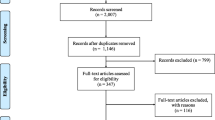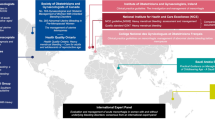Abstract
Purpose
To assess the use of complementary and alternative medicine (CAM) during pregnancy and birth and the reasons behind it from the patient’s perspective.
Methods
In a prospective study, we assessed the use of CAM before and during pregnancy as well as during delivery in women by means of a self-report questionnaire.
Results
Some 205 patients completed the questionnaire at a response rate of 43.2% (205/475) and 104 women used CAM during pregnancy, especially homoeopathy, acupuncture, and phytotherapy. Stepwise regression analysis identified CAM use prior to pregnancy, greater income, and nationality as the most important predictors of CAM use.
Conclusions
In accordance with earlier studies from Germany, we determined the most important methods used in the field of obstetrics. Interestingly, these are not evidence-based and those methods which are evidence-based are not now used. Also, the predictors of CAM use in pregnancy were similar to those in oncology. Future studies should focus on the safety and efficacy of CAM in pregnancy.


Similar content being viewed by others
References
Hofberg K, Ward MR (2003) Fear of pregnancy and childbirth. Postgrad Med J 79:505–510
Hammarberg K, Fisher JRW, Wynter KH (2008) Psychological and social aspects of pregnancy, childbirth and early parenting after assisted conception: a systematic review. Hum Reprod Update 14:395–414
Münstedt K, Kirsch K, Milch W, Sachsse S, Vahrson H (1996) Unconventional cancer therapy—survey of patients with gynaecological malignancy. Arch Gynecol Obstet 258:81–88
Low Dog T (2009) The use of botanicals during pregnancy and lactation. Altern Ther Health Med 15:54–58
Hodgson DM, Nakamura T, Walker AK (2007) Prophylactic role for complementary and alternative medicine in perinatal programming of adult health. Forsch Komplementärmed 14:92–101
Boivin J, Schmidt L (2009) Use of complementary and alternative medicines associated with a 30% lower ongoing pregnancy/live birth rate during 12 months of fertility treatment. Hum Reprod 24:1626–1631
Holst L, Wright D, Haavik S, Nordeng H (2009) The use and the user of herbal remedies during pregnancy. J Altern Complement Med 15:787–792
Nordeng H, Havnen GC (2004) Use of herbal drugs in pregnancy: a survey among 400 Norwegian women. Pharmacoepidemiol Drug Saf 13:371–380
Smith CA, Cochrane S (2009) Does acupuncture have a place as an adjunct treatment during pregnancy? A review of randomized controlled trials and systematic reviews. Birth 36:246–253
Adams J, Lui CW, Sibbritt D, Broom A, Wardle J, Homer C, Beck S (2009) Women’s use of complementary and alternative medicine during pregnancy: a critical review of the literature. Birth 36(3):237–245
Newell S, Sanson-Fisher RW (2000) Australian oncologists’ self-reported knowledge and attitudes about non-traditional therapies used by cancer patients. Med J Aust 172(3):110–113
Kappauf H, Leykauf-Ammon D, Bruntsch U, Horneber M, Kaiser G, Büschel G, Gallmeier WM (2000) Use of and attitudes held towards unconventional medicine by patients in a department of internal medicine/oncology and haematology. Support Care Cancer 8:314–322
Skouteris H, Wertheim EH, Rallis S, Paxton SJ, Kelly L, Milgrom J (2008) Use of complementary and alternative medicines by a sample of Australian women during pregnancy. Aust NZ J Obstet Gynaecol 48:384–390
Münstedt K, Brenken A, Kalder M (2009) Clinical indications and perceived effectiveness of complementary and alternative medicine in departments of obstetrics in Germany: a questionnaire study. Eur J Obstet Gynecol Reprod Biol 146:50–54
Münstedt K, Schröter C, Brüggmann D, Tinneberg HR (2009) Use of complementary and alternative medicine in departments of obstetrics in Germany. Forsch Komplementärmed 16:111–116
Wang SM, DeZinno P, Fermo L, William K, Caldwell-Andrews AA, Bravemen F, Kain ZN (2005) Complementary and alternative medicine for low-back pain in pregnancy: a cross-sectional survey. J Altern Complement Med 11:459–464
Field T (2008) Pregnancy and labor alternative therapy research. Altern Ther Health Med 14:28–34
Bayles BP (2007) Herbal and other complementary medicine use by Texas midwives. J Midwifery Women’s Health 52:473–478
Gaffney L, Smith CA (2004) Use of complementary therapies in pregnancy: the perceptions of obstetricians and midwives in South Australia. Aust NZ J Obstet Gynaecol 44:24–29
Smith CA (2003) Homoeopathy for induction of labour. Cochrane Database Syst Rev (4):CD003399. doi:10.1002/14651858.CD003399. http://mrw.interscience.wiley.com/cochrane/clsysrev/articles/CD003399/pdf_abstract_fs.hml
Nordeng H, Havnen GC (2005) Impact of socio-demographic factors, knowledge and attitude on the use of herbal drugs in pregnancy. Acta Obstet Gynecol Scand 84:23–26
Bishop FL, Lewith GT (2008) Who uses CAM? A narrative review of demographic characteristics and health factors associated with CAM use. Evid Based Complement Altern Med. 2008 Mar 13 [Epub ahead of print]
Tournaire M, Theau-Yonneau A (2007) Complementary and alternative approaches to pain relief during labor. Evid Based Complement Altern Med 4:409–417
Mårtensson L, McSwiggin M, Mercer JS (2008) US midwives’ knowledge and use of sterile water injections for labor pain. J Midwifery Women’s Health 53:115–122
Allaire AD, Moos MK, Wells SR (2000) Complementary and alternative medicine in pregnancy: a survey of North Carolina certified nurse-midwives. Obstet Gynecol 95:19–23
Adams J (2006) An exploratory study of complementary and alternative medicine in hospital midwifery: models of care and professional struggle. Complement Ther Clin Pract 12:40–47
Kalder M, Budden A, Münstedt K (2009) Komplementäre und alternative Methoden in der Geburtshilfe—Die Sicht niedergelassener Ärzte. Geburtsh Frauenheilk 69:687–691
Acknowledgments
We thank all women who participated in this study.
Conflict of interest statement
None.
Author information
Authors and Affiliations
Corresponding author
Rights and permissions
About this article
Cite this article
Kalder, M., Knoblauch, K., Hrgovic, I. et al. Use of complementary and alternative medicine during pregnancy and delivery. Arch Gynecol Obstet 283, 475–482 (2011). https://doi.org/10.1007/s00404-010-1388-2
Received:
Accepted:
Published:
Issue Date:
DOI: https://doi.org/10.1007/s00404-010-1388-2




